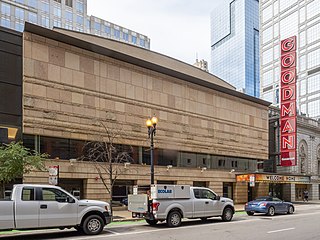
William Ordway Partridge was an American sculptor, teacher and author. Among his best-known works are the Shakespeare Monument in Chicago, the equestrian statue of General Grant in Brooklyn, the Pietà at St. Patrick's Cathedral in Manhattan, and the Pocahontas statue in Jamestown, Virginia.
Ben Iden Payne, also known as B. Iden Payne, was an English actor, director and teacher. Active in professional theatre for seventy years, he helped the first modern repertory theatre in the United Kingdom, was an early and effective advocate for Elizabethan staging of Shakespeare plays, and served as an inspiration for Shakespeare Companies and university theatre programmes throughout North America and the British Isles. A theatre at the University of Texas is named after him, as well as annual theatre awards presented in Austin, Texas.

Frank Weston Benson, frequently referred to as Frank W. Benson, was an American artist from Salem, Massachusetts, known for his Realistic portraits, American Impressionist paintings, watercolors and etchings. He began his career painting portraits of distinguished families and murals for the Library of Congress. Some of his best known paintings depict his daughters outdoors at Benson's summer home, Wooster Farm, on the island of North Haven, Maine. He also produced numerous oil, wash and watercolor paintings and etchings of wildfowl and landscapes.

Goodman Theatre is a professional theater company located in Chicago's Loop. A major part of the Chicago theatre scene, it is the city's oldest currently active nonprofit theater organization. Part of its present theater complex occupies the landmark Harris and Selwyn Theaters property.

The Old Globe is a professional theatre company in Balboa Park in San Diego, California. It produces about 15 plays and musicals annually in summer and winter seasons. Plays are performed in three separate theatres in the complex, which is collectively called the Simon Edison Centre for the Performing Arts:
Sir Edmund Kerchever Chambers,, usually known as E. K. Chambers, was an English literary critic and Shakespearean scholar. His four-volume work on The Elizabethan Stage, published in 1923, remains a standard resource.

Martin Edward Fallas Shaw was an English composer, conductor, and theatre producer. His over 300 published works include songs, hymns, carols, oratorios, several instrumental works, a congregational mass setting, and four operas including a ballad opera.
Mel Shapiro is an American theatre director and writer, college professor, and author.

Elizabeth Persis Esperance Kirmse was a British artist and illustrator known for her works of cats and dogs.

Hermann Rosse was a Dutch-American architect, illustrator, painter, theatrical designer, and art director. He won an Academy Award for Best Art Direction for the film the King of Jazz.

The Voodoo Macbeth is a common nickname for the Federal Theatre Project's 1936 New York production of William Shakespeare's Macbeth. Orson Welles adapted and directed the production, moved the play's setting from Scotland to a fictional Caribbean island, recruited an entirely Black cast, and earned the nickname for his production from the Haitian vodou that fulfilled the role of Scottish witchcraft. A box office sensation, the production is regarded as a landmark theatrical event for several reasons: its innovative interpretation of the play, its success in promoting African-American theatre, and its role in securing the reputation of its 20-year-old director.

Johannes Sophus Gelert (1852–1923) was a Danish-born sculptor, who came to the United States in 1887 and during a span of more than thirty years produced numerous works of civic art in the Midwest and on the East Coast.

Bernard Boutet de Monvel was a French painter, sculptor, engraver, fashion illustrator and interior decorator. Although first known for his etchings, he earned notability for his paintings, especially his geometric paintings from the 1900s and his Moroccan paintings made during World War I. In both Europe and the United States, where he often traveled, he also became known as a portrait painter for high society clients.
James Blanding Sloan, also known as Blanding Sloan, was an American etcher, printmaker, theatrical designer, educator, painter, and puppeteer.
Robert Bartholow Harshe (1879–1938) was an artist and museum professional who served as director of the Art Institute of Chicago from 1921 to 1938.

Herman Armour Webster was an American artist.

Gwen Lally was an English pageant master, actor, theatre producer, playwright and lecturer. Lally regularly defied gender conventions and often chose to wear 'masculine' clothing that was typical of the era, such as trousers and a top hat. As the first woman pageant maker she produced many historical pageants for smaller towns and organisations as well as major city pageants which involved casts of thousands.

Earl Horter was an American painter, illustrator, printmaker, teacher and art collector. He was instrumental in introducing modern art to Philadelphia as both an artist and collector of Cubist and abstract art. During the 1920s, he had one of the largest collections of modern art in the United States, and he was among the most prominent etchers of his generation.

Lucy Harris Feagin was an American teacher and founder of the Feagin School of Dramatic Art in New York City. She was the first woman to establish and operate a drama school in New York City where she taught students who later became prominent actors and actresses. Her students came from around the world. The New York League of Business and Professional Women in June 1938 named Feagin "as one of the twenty-five most outstanding career women of America".

Vernon H. Thomas Kirkbride Rudd Leigh was an American artist, known professionally as Vernon Thomas after 1928. She specialized in portraits of children. Her works were exhibited internationally, and appeared on magazine covers in the 1920s and 1930s.















